Related Research Articles
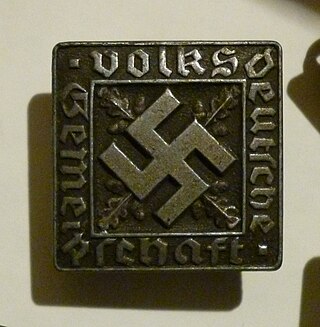
In Nazi German terminology, Volksdeutsche were "people whose language and culture had German origins but who did not hold German citizenship". The term is the nominalised plural of volksdeutsch, with Volksdeutsche denoting a singular female, and Volksdeutscher, a singular male. The words Volk and völkisch conveyed the meanings of "folk".

Veit Harlan was a German film director and actor. Harlan reached the highpoint of his career as a director in the Nazi era; most notably his antisemitic film Jud Süß (1940) makes him controversial. While viewed critically for his ideologies, a number of critics consider him a capable director on the grounds of such work as his Opfergang (1944).
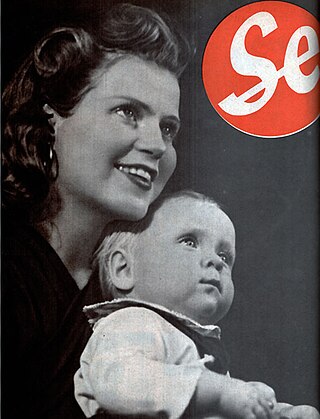
Beata Margareta Kristina Söderbaum was a Swedish-born German film actress, producer, and photographer. She performed in Nazi-era films made by a German state-controlled production company.
Feldzug in Polen is a 69-minute Nazi propaganda film released in 1940 depicting the 1939 invasion of Poland and directed by Fritz Hippler. Portraying the Poles as aggressors and ethnic Germans living in Poland as an oppressed minority, the film alleges that the Poles employed unheroic tactics in the war and characterizes as senseless the defence of a besieged Warsaw. The film was often screened by German minorities overseas to clarify the German point of view.
Heimkehr is a 1941 Nazi German anti-Polish propaganda film directed by Gustav Ucicky.
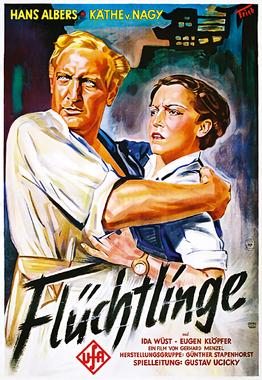
Refugees is the 1933 German drama film, directed by Gustav Ucicky and starring Hans Albers, Käthe von Nagy, and Eugen Klöpfer. It depicts Volga German refugees persecuted by the Bolsheviks on the Sino-Russian border in Manchuria in 1928.

Sieg im Westen is a 1941 Nazi propaganda film.
Wunschkonzert is a 1940 German drama propaganda film by Eduard von Borsody. After Die große Liebe, it was the most popular film of wartime Germany, reaching the second highest gross.

The Great King is a 1942 German drama film directed by Veit Harlan and starring Otto Gebühr. It depicts the life of Frederick the Great, who ruled Prussia from 1740 to 1786. It received the rare "Film of the Nation" distinction. It was part of a popular cycle of "Prussian films".
The Immortal Heart is a 1939 German drama film directed by Veit Harlan and starring Heinrich George. It was based on Walter Harlan's play The Nuremberg Egg and depicts the inventor of the watch, Peter Henlein.
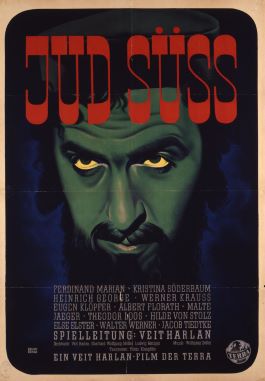
Jud Süß is a 1940 Nazi German historical drama and propaganda film produced by Terra Film at the behest of Joseph Goebbels. It is considered one of the most antisemitic films of all time. The film was directed by Veit Harlan, who wrote the screenplay with Eberhard Wolfgang Möller and Ludwig Metzger. The leading roles were played by Ferdinand Marian and Harlan's wife Kristina Söderbaum; Werner Krauss and Heinrich George played key supporting roles.

The Fox of Glenarvon is a German propaganda film from the Nazi era portraying the years of the Irish fight for independence during World War I. It was produced in 1940 by Max W. Kimmich and starred Olga Tschechowa, Karl Ludwig Diehl, Ferdinand Marian and others. The screenplay was written by Wolf Neumeister and Hans Bertram based on a novel of the same title by Nicola Rhon that had been published by the Ullstein publishing house in 1937. It was made at the Johannisthal Studios in Berlin, with sets designed by the art directors Wilhelm Depenau and Otto Erdmann. The shoot lasted from December 1939 to February 1940. It passed censorship on 22 April 1940 and had its debut in Berlin's Ufa-Palast am Zoo two days later.

Ohm Krüger is a 1941 German biographical film directed by Hans Steinhoff and starring Emil Jannings, Lucie Höflich, and Werner Hinz. It was one of a series of major propaganda films produced in Nazi Germany attacking the United Kingdom. The film depicts the life of the South African politician Paul Kruger and his eventual defeat by the British during the Boer War.
Ich klage an is a 1941 Nazi German pro-euthanasia propaganda film directed by Wolfgang Liebeneiner and produced by Heinrich Jonen and Ewald von Demandowsky.
Die goldene Stadt, is a 1942 German color film directed by Veit Harlan, starring Kristina Söderbaum, who won the Volpi Cup for Best Actress.

The propaganda of the Nazi regime that governed Germany from 1933 to 1945 promoted Nazi ideology by demonizing the enemies of the Nazi Party, notably Jews and communists, but also capitalists and intellectuals. It promoted the values asserted by the Nazis, including heroic death, Führerprinzip, Volksgemeinschaft, Blut und Boden and pride in the Germanic Herrenvolk. Propaganda was also used to maintain the cult of personality around Nazi leader Adolf Hitler, and to promote campaigns for eugenics and the annexation of German-speaking areas. After the outbreak of World War II, Nazi propaganda vilified Germany's enemies, notably the United Kingdom, the Soviet Union and the United States, and in 1943 exhorted the population to total war.

Nazi propaganda towards the United Kingdom changed its position over time in keeping with Anglo-German relations. Prior to 1938, as the Nazi regime attempted to court the British into an alliance, Nazi propaganda praised the "Aryan" character of the British people and the British Empire. However, as Anglo-German relations deteriorated, and the Second World War broke out, Nazi propaganda vilified the British as oppressive German-hating plutocrats. During the war, it accused "perfidious Albion" of war crimes and sought to drive a wedge between Britain and France.
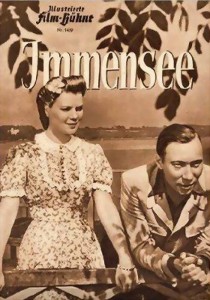
Immensee: ein deutsches Volkslied is a German film melodrama of the Nazi era, directed in 1943 by Veit Harlan and loosely based on the popular novella Immensee (1849) by Theodor Storm. It was a commercial success and, with its theme of a woman remaining faithful to her husband, was important in raising the morale of German forces; it remained popular after World War II.

The Journey to Tilsit is a 1939 German drama film directed by Veit Harlan and starring Kristina Söderbaum, Philip Dorn and Anna Dammann.
Menschen im Sturm is a 1941 German film directed by Fritz Peter Buch. It was an anti-Serbian propaganda and part of a concerted propaganda push against Serbs, attempting to split them from the Croats.
References
- ↑ "New York Times: Opfergang (1944)". Movies & TV Dept. The New York Times . 2012. Archived from the original on 2012-11-04. Retrieved 2011-07-17.
- ↑ Richard Grunberger, The 12-Year Reich, p. 382, ISBN 978-0-03-076435-6
- ↑ Robert Edwin Hertzstein, The War That Hitler Won pp. 318–319 ISBN 978-0-399-11845-6
- ↑ Cinzia Romani, Tainted Goddesses: Female Film Stars of the Third Reich p. 87 ISBN 978-0-9627613-1-7
- 1 2 Cinzia Romani, Tainted Goddesses: Female Film Stars of the Third Reich p. 20 ISBN 978-0-9627613-1-7
- ↑ Robert Edwin Hertzstein, The War That Hitler Won p. 320 ISBN 978-0-399-11845-6
- ↑ Robert Edwin Hertzstein, The War That Hitler Won p. 272 ISBN 978-0-399-11845-6
- ↑ "Votes for OPFERGANG (1944) | BFI". Archived from the original on April 19, 2022.
- ↑ "Hallucination as Ideology in Cinema - No Subject - Encyclopedia of Psychoanalysis - Encyclopedia of Lacanian Psychoanalysis". 24 May 2019.
- ↑ Harlan, Veit, director. Opfergang. UFA, 1944.
- ↑ Williams, Linda. “Film Bodies: Gender, Genre, and Excess.” Film Quarterly, vol. 44, no. 4, 1991, pp. 2–13. JSTOR, https://doi.org/10.2307/1212758. Accessed 23 Oct. 2023.
- ↑ Heins, Laura. “An Aesthetics of Aggression: German Fascist vs. Classical Hollywood Melodrama.” Nazi Film Melodrama, Univ. of Illinois Press, 2013, pp. 13–44.